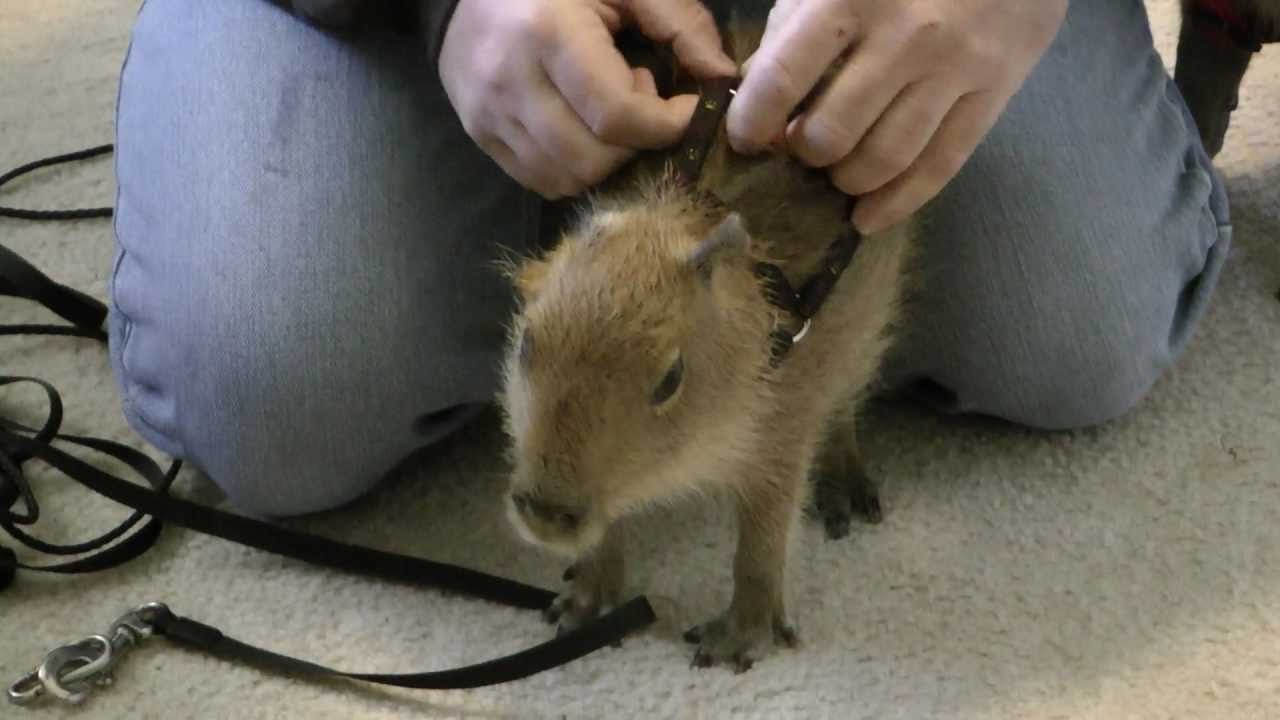Table of Contents
Imagine strolling through a park on a sunny day, basking in the warmth of the sun and feeling a light breeze. Amidst the bustling chatter of people, something catches your eye. You do a double-take as you spot an adorable capybara leisurely walking beside its owner on a leash. A smile spreads across your face as you witness this unique sight, marveling at the bond between human and the world’s largest rodent. It’s a moment that fills your heart with joy and curiosity, leaving you intrigued about the fascinating world of capybaras and the special relationships they form with their human companions.

The Fascinating World of Capybaras
Physical Characteristics
Capybaras, the largest rodents in the world, have a distinct appearance that sets them apart from other animals. With a stocky body covered in short, coarse hair, they can grow to be around four feet long and weigh up to 150 pounds. Their round, pig-like snouts and small ears add to their charming and unique look. Capybaras have webbed feet, which make them excellent swimmers. Their teeth continue to grow throughout their lives, allowing them to maintain their pearly whites.
Habitat and Distribution
These extraordinary creatures are native to South America, specifically found in regions such as Brazil, Colombia, Venezuela, and Uruguay. Capybaras thrive in warm and tropical environments, primarily inhabiting areas near bodies of water such as rivers, lakes, and marshes. They are well-adapted to aquatic life and can often be spotted lounging by the water’s edge or taking an occasional dip to cool off.
Behavior and Communication
Capybaras are incredibly social animals, often living in groups called herds or mobs that can consist of several individuals. They communicate through a combination of vocalizations, body language, and scent marking. Purring, whistling, barking, and even clicking sounds are among their array of vocal expressions. These intelligent creatures also use their scent glands to mark their territory and communicate with other capybaras.
Training and Walking Capybaras on a Leash
Benefits of Training Capybaras
Training capybaras not only ensures their physical and mental well-being but also strengthens the bond between the animal and its owner. Capybaras can be taught basic commands, such as sit, stay, and come, which can be incredibly useful in various situations. Additionally, training provides mental stimulation and helps prevent boredom in these intelligent creatures.
Preparing for Training
Before diving into training sessions, it’s crucial to create a calm and safe environment for your capybara. Familiarize yourself with their temperament and preferences to understand how to motivate and reward them effectively. Patience and consistency are key when working with capybaras, as they are generally gentle but can be easily startled due to their inherent wariness of potential threats.
Choosing the Right Leash
Selecting an appropriate leash is essential for walking capybaras. Look for a sturdy leash made of nylon or a similar durable material. It should be long enough to allow your capybara ample room to move but short enough to maintain control. Be sure to avoid using retractable leashes, as they can be unsafe and difficult to manage.
Training Techniques
Positive reinforcement techniques, such as offering treats and verbal praise, work well when training capybaras. Start with small, achievable tasks and gradually increase the complexity of commands. Stay patient and persistent, providing consistent reinforcement when your capybara follows instructions correctly. Remember to always emphasize the well-being and comfort of your capybara throughout the training process.

Understanding Capybara Behavior
Social Structure
Capybaras thrive in a social structure known as a herd or mob. These groups, which can consist of as few as three or as many as thirty members, have a hierarchical organization. The alpha male and female hold the highest rank, with the other members following their lead. Capybaras establish strong social bonds within their herds, often engaging in mutual grooming and playful interactions.
Hunting and Feeding
Contrary to their herbivorous nature, capybaras do not hunt for prey but instead graze on grasses and aquatic plants. They possess a unique digestive system that allows them to efficiently break down vegetation. Water plays a crucial role in their diet, as they consume both water plants and use it as a means to regulate their body temperature and stay hydrated.
Grooming and Personal Care
Capybaras are fastidious groomers, often spending a significant amount of time cleaning their coats. They use their sharp teeth to remove parasites, debris, and excess hair from their fur. Mutual grooming is also observed within a herd, promoting social bonding and reinforcing relationships between members. This attention to personal care helps keep their coats healthy and prevents skin issues.
Reproduction and Parenting
Capybaras are known for their strong parental instincts. The mating season typically occurs in the rainy season, with females giving birth to litters of one to eight pups after a gestation period of around 150 days. The young capybaras are born fully furred and are capable of walking and swimming shortly after birth. Mothers are highly protective of their offspring, nurturing and caring for them until they are independent enough to join the herd.
Capybaras as Pets
Legal Considerations
Before considering capybara ownership, it is crucial to research and understand the legal considerations and regulations regarding keeping them as pets. Some regions prohibit owning capybaras outright, while others have specific licensing requirements or restrictions. Consult local authorities and exotic pet laws to ensure compliance and the well-being of both the animal and yourself.
Housing and Enclosure
Providing an appropriate habitat and enclosure is essential for pet capybaras. They require a large outdoor area with access to water for swimming, as well as ample space to roam and graze. Fencing should be secure and high enough to prevent escapes, as capybaras are excellent jumpers. Equipping the enclosure with shaded areas, hiding places, and appropriate vegetation will help recreate their natural habitat and ensure their comfort.
Nutrition and Diet
A balanced diet is crucial for the health and well-being of pet capybaras. Their primary diet should consist of high-quality grasses, leafy vegetables, and hay. Additionally, commercial capybara pellets can supplement their nutritional needs. Fresh water should always be readily available, as hydration is essential for their overall health. Consult with a veterinarian or exotic animal specialist to tailor a suitable diet for your capybara.
Healthcare and Veterinary Needs
Capybaras require regular veterinary check-ups to ensure their optimum health. Find a veterinarian experienced in working with exotic animals who can provide necessary vaccinations and preventive care. Regular dental care, including monitoring tooth growth and providing appropriate chew toys, is essential to maintain your capybara’s dental health. Additionally, parasite prevention and prompt medical attention for any signs of illness or injury are vital to their well-being.

Alternative Perspectives on Capybara Ownership
Ethical Concerns
While capybaras can be adorable and charming companions, it is important to consider the ethical implications of keeping them as pets. As exotic animals, they have specific needs and requirements that may be challenging for some individuals to fulfill. It is crucial to prioritize the well-being and natural behaviors of capybaras and ensure they are not exploited or subjected to unnecessary stress or harm.
Conservation Efforts
Capybaras, like many other wildlife species, face threats such as habitat loss and human encroachment. Supporting conservation efforts aimed at protecting their natural habitats and promoting sustainable practices is crucial to their long-term survival. Organizations dedicated to wildlife preservation work towards maintaining healthy capybara populations and protecting their ecosystems.
Alternatives to Keeping Capybaras as Pets
For those who find themselves captivated by the charm of capybaras but are not equipped to care for them as pets, there are alternative ways to admire and interact with these fascinating creatures. Visiting accredited zoos or wildlife sanctuaries allows individuals to observe and learn about capybaras in a controlled and ethical setting. Some organizations even offer unique opportunities to volunteer or participate in educational programs involving capybaras and other wildlife.
Frequently Asked Questions
Are Capybaras Dangerous?
Capybaras are generally docile and non-aggressive animals. However, as with any animal, caution should be exercised, especially when dealing with unfamiliar or stressed capybaras. While they are unlikely to attack humans, it is crucial to understand their natural behaviors and respect their need for personal space to avoid any potential mishaps.
Can Capybaras be Trained like Dogs?
While capybaras are intelligent animals, it is important to recognize that they have unique instincts and behaviors that differentiate them from domesticated dogs. Capybaras have their own trainability, but it requires patience, consistency, and understanding of their natural tendencies. With proper training techniques and a strong bond, capybaras can learn basic commands and behaviors.
What are the Legal Restrictions for Keeping Capybaras?
Legal restrictions regarding capybara ownership can vary by region and country. It is crucial to research and comply with local laws and regulations before considering capybara ownership. Some areas prohibit owning them as pets, while others require specific permits or licenses. Consulting local authorities or exotic pet organizations can provide valuable information regarding legal restrictions.
Can Capybaras Live with Other Pets?
Capybaras have a social nature and can potentially form bonds with some other species. However, introducing them to other pets should be done with caution and guidance from an experienced professional. Each individual animal and species has unique characteristics and behaviors that need to be considered when determining compatibility. It is important to prioritize the safety and well-being of all animals involved.
How Much Exercise do Capybaras Need?
Capybaras are active animals that require plenty of exercise to maintain their physical and mental well-being. A large outdoor enclosure with room to roam and graze is essential. Additionally, providing opportunities for swimming and engaging in natural behaviors is crucial. Regular exercise, such as supervised walks, can also be incorporated into their routine to ensure they stay healthy and mentally stimulated.


